Membership organizations need to look for new ways to stay relevant in today’s dynamic landscape. In fact, they are required to address a myriad of challenges to survive and reach sustainable growth in a post-pandemic economy. In this blog post, we will take a quick look at these challenges and offer proven strategies to address them in membership associations and reach continuous growth.

Post-pandemic economy forces membership organizations to re-evaluate the way they do business.
Top Challenges of Membership Organizations, According to Executives
The findings of a survey conducted by Direct Objective in late 2023 across Canadian member-based associations in various industries, shed light on the primary challenges perceived by the leaders of these organizations. These are their top five concerns:
-
-
- Attracting diverse audiences, especially the new generation
- Adapting to shifting technologies
- Improving data management
- Enhancing operational processes, and
- Securing financial sustainability
-
Post-Pandemic Trends Affecting Canadian Associations’ Success
Apart from the survey results, there are specific trends that call for strategic adaptation and innovative approaches to meet the diverse needs of the members. The most important ones are:
-
-
- Revenue Loss
-
Economic uncertainties, including high inflation rates and a dramatic increase in prices, have led to smaller budgets for professionals, companies, and organizations, which is limiting the scope of spending across various sectors.
-
-
- Changes in Preferences, Required Skills, and Technology
-
The professional landscape has witnessed a profound transformation in work-related habits, preferences, and requirements after the pandemic. These include remote or hybrid work, virtual meetings, and the necessity of acquiring new skills, technologies or designations.
-
-
- Elevated Significance of Human Connection
-
In a world in which businesses are progressively using virtual or AI-assisted solutions, building and maintaining human relationships has become a critical mission for associations.
-
-
- Roller Coaster in the Unemployment Rate
-
The current economic climate has seen a slight uptick in the unemployment rate. This has prompted professionals to explore new avenues for career advancement and personal growth, including professional designations and networking opportunities.
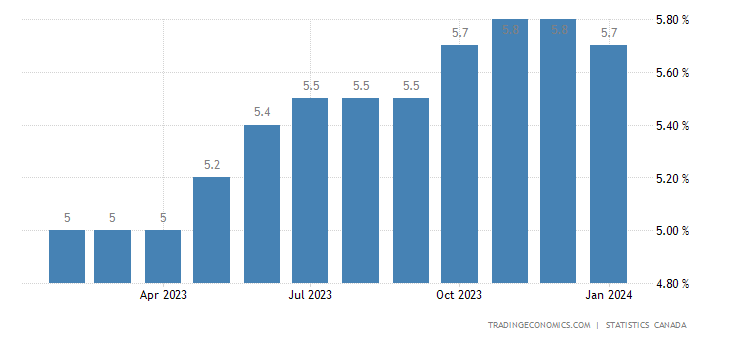
The Canadian unemployment rate during the past year (Trading Economics)
-
-
- Rapidly Aging Canadian Labour Force
-
With one in five Canadian workers being 55 years or older, this demographic shift underscores the importance of making sure the Canadian market has enough skilled workforce.
-
-
- The “Great Retirement” in Canada
-
Around 700,000 skilled trades workers are expected to retire by 2028, marking a significant generational shift in the workforce. By 2029, Millennials are projected to outnumber Baby Boomers. Gen Z could outnumber Baby Boomers in 2032 and Millennials in 2045. This will be accompanied by a shift in work and business culture as well, meaning that future associations will service diverse audiences, especially a new generation with new needs.
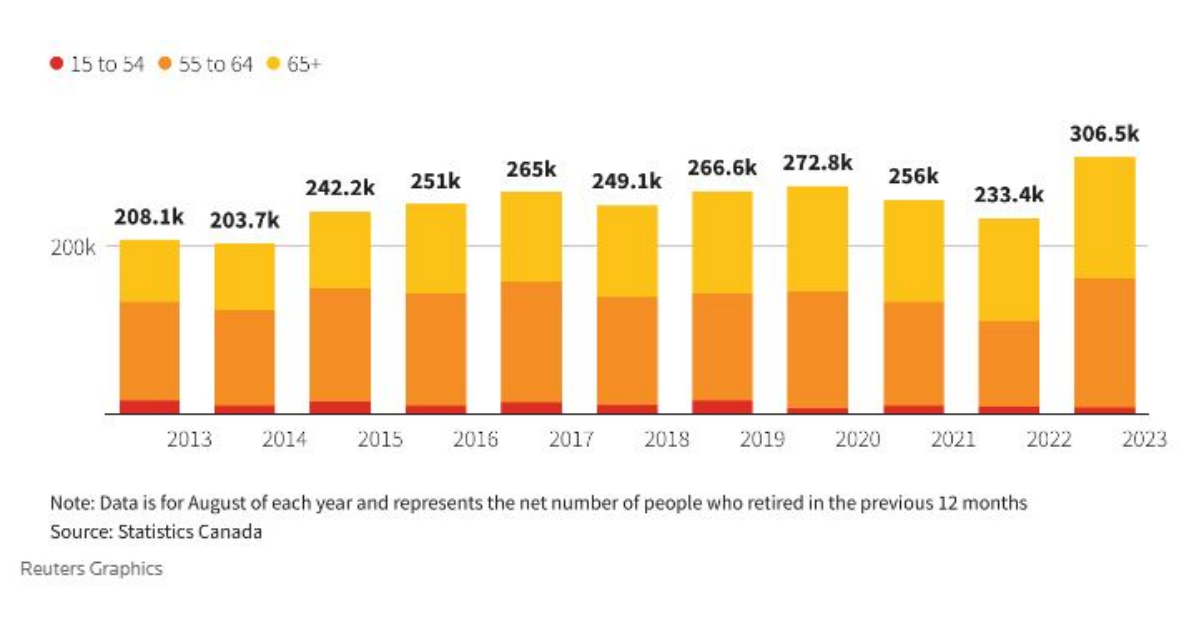

What's Your MarketingReadyTM Ranking?
Click here to assess your business’ B2B Marketing Proficiency
How Membership Organizations Can Survive the Challenges and Grow?
Based on our extensive experience working with membership associations and helping them grow, we highly recommend the following strategies to navigate and thrive in this dynamic environment:
-
-
- Sharpening the Value for Members
- Building a Network of Partners and Sponsors
- Increasing Brand Awareness
- Perfecting Member Acquisition
- Filling Up Events/Seminars/Courses
- Investing in Retention
-
-
Sharpening the Value for Members
You can learn a lot from existing, prospective, and lapsed members. In order to sharpen the value for members, we recommend to perform the following actions to get the best results:
-
-
- Conduct needs assessments within existing members and prospective member base.
- Conduct member satisfaction surveys, such as NPS (Net Promoter Score), to estimate how close your association is to providing value to your member base. One common challenge is that member satisfaction surveys can yield misleading results, If not administered well. Apart from online survey fatigue, most member satisfaction surveys are too generic, and members see only the hassle of answering them. In most cases, only the most engaged members would answer them, which can lead to biased results. We’ve seen associations with 96% satisfaction level and yet very low retention rates. Thus, we suggest putting emphasis on timing, member engagement at different maturity levels, and keeping the human-to-human relationship.
- Get feedback from lapsed members. Without knowing why members decide not to renew, your member understanding is not complete. You’d be surprised at how vocal, informative, and valuable the lapsed members’ feedback is.
- Re-assess revenue sources and, based on the needs and goals of your audience, suggest innovative services or solutions that answer these needs.
-
-
Building a Network of Partners and Sponsors
A strong ecosystem allows service-based organizations to thrive. Facilitating the development of partnerships, alliances, and sponsorship opportunities will lead to win-win growth situations and financial stability.
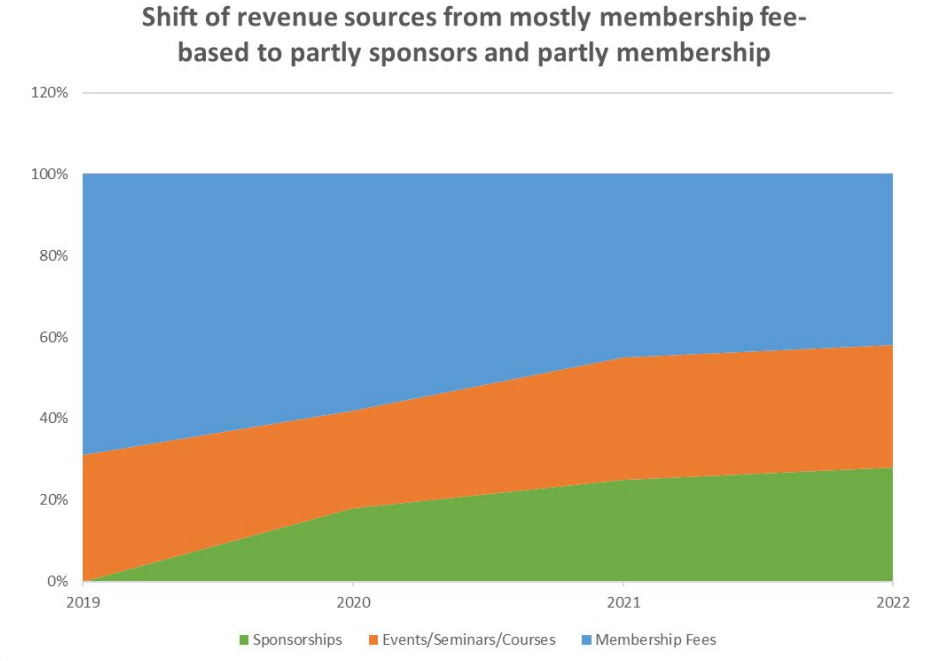
As an example, an association came to us in 2019 with about 70% of their revenue relying on membership fees. The above diagram shows the gradual diversification in revenue sources that this association managed to achieve with our help. After 3 years, the sponsorship revenue that we introduced grew to become 28% of their revenue. During the pandemic, we also helped them shift to virtual events and seminars as they were struggling to keep the revenue coming from events and seminars. With this strategy, they were able to recuperate similar pre-pandemic revenue from this source.
-
Increasing Brand Awareness
Now that we have sharpened the value for potential members, we must make an effort to reach target audiences and to keep the association top-of-mind, improving their brand awareness. In general, the brand awareness phase has two main goals:
-
-
- Educating prospective members about the value of becoming a member
- Building the required trust to be associated with the association
-
-
Boosting Member Recruitment
While you demonstrate the value of your association and increase brand awareness, every association must run lead-generation campaigns in tandem. Here are few guidelines to follow:
-
-
- Use various media (e.g., infographics, webinars, videos, interactive tools, eBooks, podcasts, case studies, blogs)
- Leverage diverse channels (e.g., organic and paid search, social media, chatbots, influencers)
- Do not neglect traditional channels (e.g., direct mailing, telemarketing, media placement, partners)
- Leverage sophisticated technologies to better understand prospective member behaviour
- Integrate, integrate, and integrate
- Monitor, analyze, and improve
-

Member recruiting growth across Canada (2014 – 2022)
Here is an interesting case study: an association hired us in 2013 to handle their Quebec member recruitment, from building initial lists to completing membership forms. In 2017, after experiencing a 33% member growth, this association decided to offer us to do also recruitment across Canada.
2023 has been the 10th year that we are working with this association and apart from a slight decline during the pandemic, we were able to deliver continuous growth.
When the pandemic broke out, this association consulted with us about whether they should pause spending their marketing budget. We suggested that as long as we are able to recruit new members, we should not stop the campaigns. Therefore, the decline was relatively marginal, and the results bounced to higher recruitment levels than before the pandemic.
Whether you are operating provincially, nationally, or internationally, continuously identify prospective members and educate them on what you offer. Not only create demand and interest but nurture the prospects, making sure they have all the information to become members.
-
Filling Up Your Events/Seminars/Courses
Are you a membership association with a mission to educate your industry about the best practices or the latest regulations in the market? Then, you need to maximize enrollments for your online/in-person seminars, courses, webinars, and conferences.
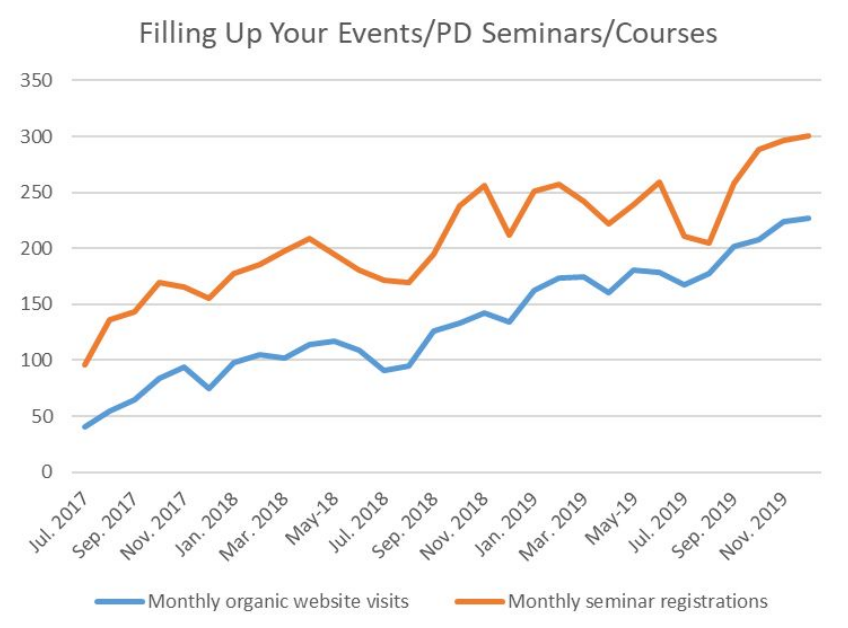
Here’s another case study from a different organization that the majority of their revenue comes from educating professionals. In this case, our strategy was to ensure that when a targeted professional is looking for a specific training, this organization will appear on the top search results of Google and other search engines.
Being on the first pages organically allowed this organization to:
-
-
- Increase awareness of the education opportunities for professionals in the field
- Gain a reputation as the leader in education in this market
- Sign up professionals for its ongoing professional programs
-
-
Investing in Retention
To ensure the viability of your organization, simply acquiring new members won’t cut it. Our experience demonstrates that you must continuously invest in securing membership renewals. Once you identify the major cause of the membership churn rate, you are able to slowly minimize the amount of lapsed members while encouraging the renewal process using higher engagement programs.
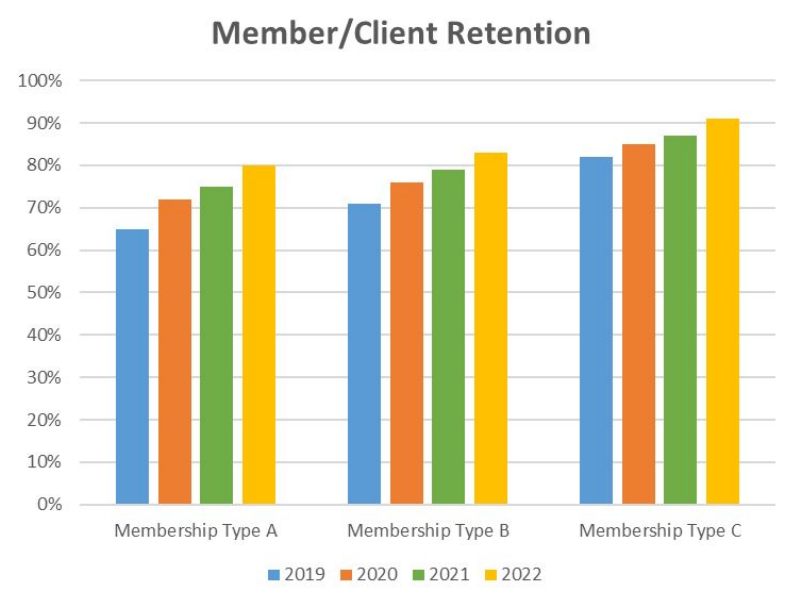
As an example, an association with 3 membership types approached us, with 65%, 70%, and 82% retention rates for type A, B, and C memberships, respectively. After analyzing their membership journey, implementing a need assessment analysis, and conducting a member satisfaction survey, we found that they have not invested enough in the retention of existing members.
The association was going through an amazing evolution, but this was never communicated well enough to the existing members. The result was a drop in membership due to a lack of communication. Based on the assessed membership journey, we designed an engagement program for major touchpoints, leading to a retention increase of 23%, 17%, and 11% for type A, B, and C memberships, respectively, over a period of 3 years, the COVID19 period included.
Membership experience is the most critical factor when it comes to satisfaction levels, engagement, and retention rates. The key is to understand how you can incorporate junctions of engagement throughout the membership journey to ensure continuous value reinforcement, with a special emphasis on the security and privacy of member data, as one of the building blocks of trust between the association and its members.
Association Success: Final Words
Member-based associations, around the world and in Canada, stand at the crossroads of numerous challenges, each demanding a well-thought response to ensure continued relevance and success. However, armed with a deeper understanding, associations can proactively tackle these challenges, from attracting diverse audiences, including the new generation, to navigating the complexities of new technologies, and securing financial sustainability.
By embracing innovative marketing, digital engagement strategies, tailored communication, technology integration, continuous training, and data-driven decision-making, member-based associations can ensure adaptability in the face of evolving trends.
Streamlining operational processes, fostering a culture of improvement, and diversifying revenue streams, all contribute to a resilient foundation. The key lies in a holistic and forward-thinking approach that positions Membership organizations not just to survive, but to thrive amid the challenges that define the contemporary professional landscape.
Feel ready to tackle your challenges?
Contact Direct Objective Consulting for a complimentary session to discuss how you can reach your goals this year.










